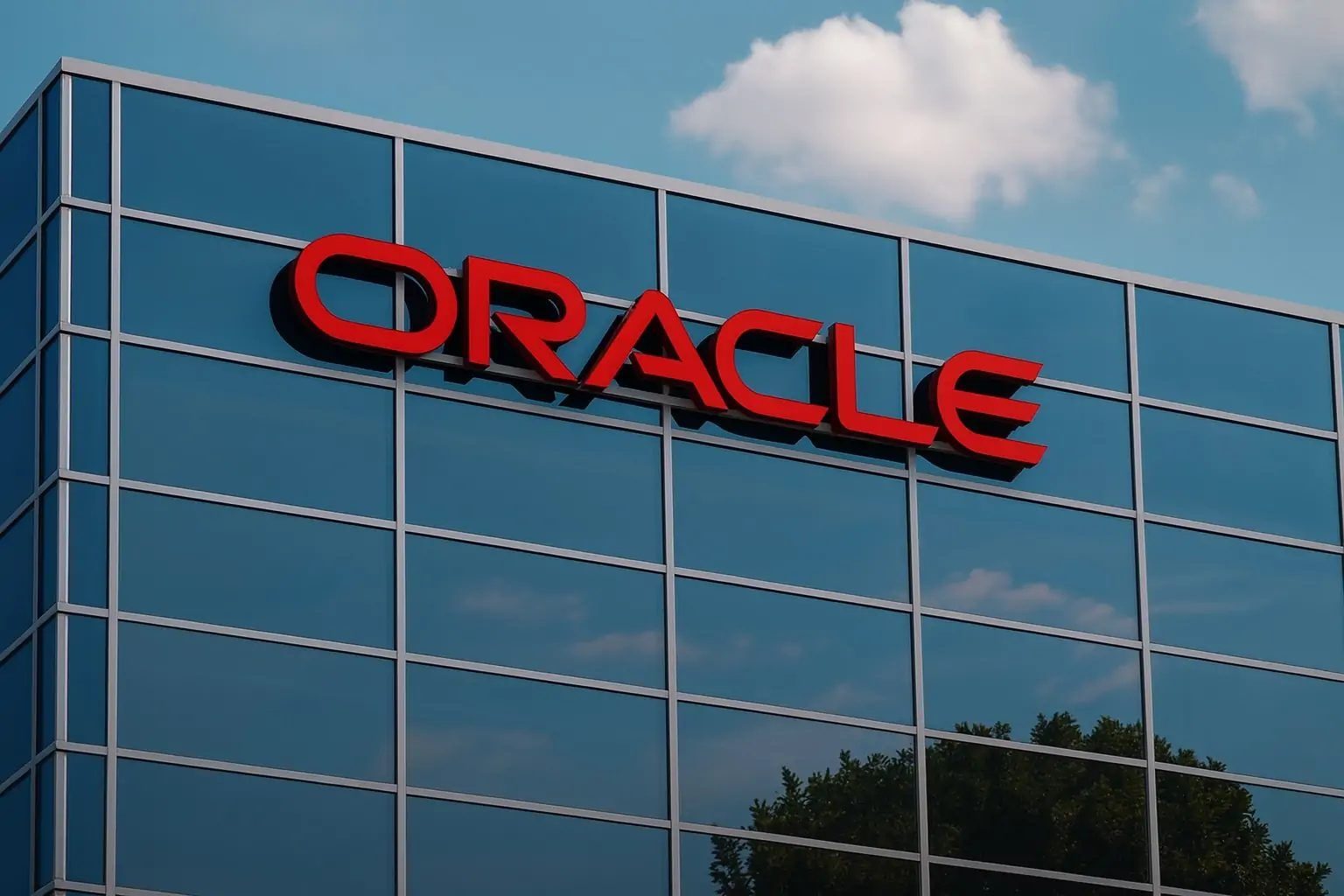Oracle Corporation (NYSE: ORCL) is ending November under heavy pressure. As of the close on November 25, 2025, Oracle stock finished around $194.8, down roughly 2.7% on the day and well below its late‑summer peak. [1]
That close leaves ORCL about 44% under its 52‑week high near $346, even though it’s still trading well above its 52‑week low of roughly $119. [2] The contrast captures the story of 2025: a spectacular AI‑driven melt‑up followed by an equally dramatic reset in expectations.
Below is a detailed look at Oracle stock today, what’s driving the sell‑off, and the key numbers investors are watching.
Oracle stock today: key numbers for November 25, 2025
Price & daily move
- Close: about $194.79
- Change: roughly –$5.5 to –$5.6, or –2.7% vs. the prior close near $200.3
- Intraday range: approximately $186–$197
- Volume: just under 16 million shares, close to the recent average. [3]
Volatility & drawdown
- ORCL is down about 29% over the last 21 trading days, according to multiple performance trackers. [4]
- Over roughly the past two months, the stock has shed more than 40% from its September all‑time highs above $300. [5]
- Despite that, ORCL remains meaningfully up for 2025 overall after an earlier AI‑powered surge that briefly pushed Oracle toward the $1 trillion market‑cap club. [6]
Context in the AI trade
Oracle has become one of the market’s purest proxies for the AI infrastructure boom. Its stock is now at the center of a debate: is this a healthy shakeout after irrational AI exuberance, or the start of a deeper, debt‑driven unwind?
From AI darling to AI doubts: why ORCL is 40% off its highs
Earlier this year, Oracle transformed from a “steady database incumbent” into a full‑blown AI momentum stock:
- Shares soared after blowout earnings in September, when Oracle reported a massive $455 billion cloud backlog and highlighted multi‑billion‑dollar AI contracts. [7]
- A wave of coverage around a $300 billion cloud compute deal with OpenAI and a $500 billion “Stargate” AI infrastructure project with OpenAI and SoftBank helped fuel the rally. [8]
But as autumn rolled on, the narrative flipped.
1. Earnings and guidance didn’t fully match the hype
Oracle’s most recent reported quarter (fiscal Q1 2026, published September 9) was fundamentally solid:
- Revenue: $14.9 billion, +12% YoY
- Cloud (IaaS + SaaS): $7.2 billion, +28% YoY
- Cloud infrastructure (IaaS): $3.3 billion, +55% YoY
- Non‑GAAP EPS: $1.47, up 6% YoY. [9]
However, revenue and EPS slightly missed consensus estimates (roughly $15.0 billion and $1.48), and guidance for the following quarter was only modestly ahead of expectations. [10]
For a stock that had just re‑rated to AI‑bubble valuations, small shortfalls mattered. Commentaries from Trefis, Simply Wall St, and others all point to this expectations vs. reality gap as a core trigger for the recent 29–40% drawdown. [11]
2. Heavy AI capex and rising debt are spooking the market
Backing up the AI story, Oracle is committing to a huge infrastructure build‑out:
- Capital spending is set to jump to about $35 billion in fiscal 2026, up from roughly $21 billion in fiscal 2025, largely for AI data centers. [12]
- The company has reportedly raised around $18 billion in new debt, pushing total debt above $100 billion, and could borrow tens of billions more for projects like Stargate. [13]
Analysts and strategists increasingly worry about:
- How quickly these AI data centers can translate into free cash flow.
- Whether Oracle’s leverage and widening credit‑default swap spreads signal that the balance sheet is being stretched too far for contracts whose ultimate usage may be uncertain. [14]
This is happening against a backdrop of a broader AI sentiment shift, where investors have started to question multi‑hundred‑billion‑dollar capex plans across the hyperscaler universe. [15]
3. Technical breakdown and worst month in decades
From a technical perspective, ORCL has suffered a full trend break:
- The stock recently slid below its 200‑day moving average and hit its lowest level since June, according to technical analysis from Investor’s Business Daily and EBC. [16]
- Oracle is on track for one of its worst monthly drops since 2002, with November losses in the mid‑20% range. [17]
- Daily indicator dashboards now show a cluster of “strong sell” signals, with price trading below all major moving averages and momentum oscillators hovering near oversold levels. [18]
Once a high‑flying AI trade breaks through these levels, systematic and algorithmic selling can reinforce the move.
4. Big‑name skepticism and accounting questions
High‑profile critics have added fuel:
- Michael Burry has argued that companies like Oracle and Meta may be using overly long depreciation schedules for AI hardware, which could overstate earnings by more than 20% over the next few years; Oracle has been singled out in that discussion. [19]
- Some analysts question whether Oracle’s AI backlog, especially the OpenAI‑related portion, fully represents committed demand versus more flexible “framework” agreements. [20]
To be clear, no regulator has accused Oracle of wrongdoing, and there are no announced enforcement actions tied to these concerns. For now, this is an investor‑driven debate about assumptions and presentation, not a legal case.
5. Leadership change and insider selling
In September, Oracle announced that long‑time CEO Safra Catz would move into the role of executive vice chair, while Clay Magouyrk (OCI) and Mike Sicilia (industry applications) became co‑CEOs — a clear signal that Oracle sees AI and cloud as the center of its strategy. [21]
The market initially took the move positively, but follow‑on insider stock sales near the highs and the sheer scale of the AI bet have fed a narrative that management may be “de‑risking” personally while investors carry the volatility. [22]
Underlying business still strong: AI and cloud numbers remain robust
The sell‑off is not about a collapsing business. Oracle’s fundamentals are still, on paper, quite strong.
Fiscal 2025: solid growth and rising profitability
For the fiscal year ended May 2025, Oracle reported: [23]
- Total revenue: $57.4 billion, +8% YoY
- Cloud services + license support: $44.0 billion, +12% YoY
- Q4 FY25 revenue: $15.9 billion, +11% YoY
- Q4 cloud revenue: $6.7 billion, +27% YoY
- Non‑GAAP EPS:$6.03 for the full year, with non‑GAAP operating income of $25.0 billion
Oracle is increasingly a cloud and AI infrastructure company, not just a traditional database vendor.
Fiscal 2026 Q1: the AI backlog explodes
Oracle’s first quarter of fiscal 2026 highlighted the scale of its AI opportunity: [24]
- Total revenue: $14.9 billion, +12% YoY
- Cloud (IaaS + SaaS): $7.2 billion, +28% YoY
- Cloud infrastructure (OCI): $3.3 billion, +55% YoY
- Cloud applications (SaaS): $3.8 billion, +11% YoY
- Fusion Cloud ERP revenue: $1.0 billion, +17% YoY
- NetSuite revenue: $1.0 billion, +16% YoY
- Non‑GAAP EPS: $1.47, +6% YoY, despite higher AI‑related costs
Most striking was the Remaining Performance Obligations (RPO) — effectively Oracle’s contracted backlog — which jumped 359% year‑over‑year to $455 billion, largely reflecting multi‑year AI and cloud deals. [25]
Oracle itself has guided to:
- Cloud infrastructure revenue (OCI) growing roughly 77% this fiscal year to $18 billion
- OCI revenues rising to roughly $144 billion within five years, based mainly on already‑signed contracts. [26]
That is the bull case in a nutshell: a huge, contracted AI backlog that could support high growth for many years — if the economics ultimately work.
AI superclusters, OpenAI and sovereign cloud: Oracle’s big bets
Beyond the headline numbers, Oracle is aggressively positioning itself as the infrastructure layer for AI across both public and sovereign clouds.
OpenAI, Stargate and multi‑cloud AI
- Oracle is deeply involved in multi‑hundred‑billion‑dollar AI infrastructure projects with OpenAI and SoftBank, including the much‑discussed Stargate initiative, which aims to build out gigantic U.S. data center capacity. [27]
- Reuters and other outlets have reported that OpenAI signed a $300 billion cloud compute deal with Oracle, one of the largest such agreements in history. [28]
Oracle is also aggressively promoting its MultiCloud AI Database, allowing customers to run large language models like ChatGPT, Gemini, or Grok directly on Oracle databases across clouds. [29]
Sovereign AI and regional superclusters
Oracle is combining AI with data sovereignty:
- In October, at Oracle AI World, the company launched OCI Dedicated Region 25 and the Oracle AI Data Platform, bringing more than 200 AI and cloud services directly into customer or government data centers with a smaller physical footprint. [30]
- On November 24, Oracle announced a major expansion of its Abu Dhabi cloud region with the Middle East’s first Oracle AI Supercluster, powered by more than 4,000 NVIDIA Blackwell GPUs. The deployment is designed to support sovereign AI initiatives and Abu Dhabi’s ambition to be the world’s first fully AI‑native government by 2027. [31]
Long‑term targets
Oracle has outlined an aggressive long‑term vision:
- It targets roughly $225 billion in annual sales by 2030, with about $166 billion expected from cloud infrastructure alone. [32]
Taken together, these moves underpin why so many analysts still see Oracle as one of the key AI infrastructure winners — even as its stock is punished in the short term.
Valuation check: how expensive is Oracle stock after the drop?
At ~$195 per share, ORCL looks very different than it did at $330–$340, but it is not cheap in absolute terms.
Using Oracle’s fiscal 2025 results: [33]
- Non‑GAAP EPS FY25: $6.03
- Implied non‑GAAP P/E: roughly 32× at today’s price.
- GAAP EPS FY25: $4.34
- Implied GAAP P/E: in the mid‑40s, around 45×, broadly in line with third‑party data services that still show Oracle trading near a mid‑40s trailing multiple. [34]
On forward numbers:
- Zacks estimates fiscal 2026 EPS around $6.81, implying a forward multiple in the high‑20s. [35]
- Zacks also notes a forward 12‑month price/sales ratio around 7.6×, slightly above the industry average, giving ORCL a “Value Score” of D despite the recent pullback. [36]
Compared with other mega‑cap cloud and AI names, Oracle’s growth is strong, but so are its leverage and valuation, which is why opinions are so sharply divided.
What Wall Street is saying about Oracle stock today
Despite the drawdown, most analysts remain positive:
- Across major aggregators, Oracle carries a “Moderate Buy” or “Buy” consensus, with roughly 25–30 Buy ratings, 8–12 Hold ratings, and only 1–2 Sell ratings. [37]
- Average 12‑month price targets generally cluster between $320 and $345, implying 60–75% upside from current levels, with some high targets up near $400–$415 and lows around $130–$175. [38]
However, the tone is shifting at the margin:
- D.A. Davidson today cut its price target to $200 from $300 while maintaining a Neutral rating, warning that Oracle’s surge in backlog appears entirely driven by OpenAI and that rising credit insurance costs show markets are uneasy about the debt‑funded build‑out. [39]
- Other brokers have recently trimmed targets as well, even while keeping Outperform or Overweight ratings. [40]
- According to Bloomberg radio commentary, CFRA has downgraded ORCL to “Hold” from “Buy”, citing mounting debt concerns as total borrowings exceed $100 billion. [41]
In short: the average Wall Street view is still bullish, but the distribution is widening — more cautious neutral calls and a few outright bearish voices have appeared as the AI trade cools.
Key catalysts for Oracle stock over the next few weeks
For investors trying to handicap ORCL’s next move, several upcoming catalysts stand out.
1. December earnings (fiscal Q2 2026)
Oracle is expected to report its next quarter in December, with many earnings calendars pointing to early‑to‑mid month. [42]
Consensus expectations:
- EPS: around $1.29 for the quarter ending November 2025. [43]
Investors will be laser‑focused on:
- Cloud infrastructure growth: can OCI sustain 50%+ growth as capacity ramps?
- Margin trajectory: does operating leverage improve, or do AI‑related costs keep compressing margins?
- Capex guidance: any signs that Oracle will dial back spending from the projected $35 billion run rate. [44]
2. Updated debt & credit‑market signals
Given the size of Oracle’s borrowing program, markets will be watching for: [45]
- New bond issuance or revisions to funding plans.
- Changes in credit ratings or spreads.
- Any commentary from management on balancing growth vs. balance‑sheet risk.
3. AI wins and sovereign cloud deployments
New deals and deployments could help rebuild confidence if they show:
- Conversion of backlog into recognized revenue and cash, not just impressive headline figures. [46]
- Further sovereign AI wins, following the Abu Dhabi Blackwell Supercluster, in regions where governments demand in‑country AI infrastructure. [47]
4. Macro and AI sector sentiment
Oracle is now tightly linked to the AI trade in investors’ minds. Broad swings in:
- AI chip names,
- hyperscaler capex commentary, and
- regulatory or political headlines around AI
can all move ORCL, even independent of its own news. [48]
Bottom line: a high‑beta AI infrastructure play with real execution risk
For bulls, the case for Oracle stock today rests on:
- A 455‑billion‑dollar contracted backlog and multi‑year AI deals that could support rapid growth well into the 2030s. [49]
- Cloud infrastructure revenue growing 50–70%+ annually, flipping Oracle from “legacy database” to top‑tier AI cloud provider. [50]
- A stock that has already fallen more than 40% in two months, potentially resetting expectations to more reasonable levels while fundamentals remain intact. [51]
For bears and skeptics, the concerns are equally clear:
- Leverage north of $100 billion and a plan to spend tens of billions more on AI data centers, just as investors are starting to question AI capex returns. [52]
- Heavy dependence on OpenAI for backlog growth, with some analysts arguing the commitments may be more flexible than they first appeared. [53]
- A valuation that still implies high expectations — especially on GAAP earnings — even after the recent sell‑off. [54]
- Technicals that remain firmly in downtrend territory, which can keep traders cautious until the chart repairs itself. [55]
For short‑term traders, ORCL is likely to remain a high‑beta, headline‑driven AI proxy, whipping around on any new data about AI spending or OpenAI‑related deals.
For long‑term investors, the key questions are:
- Can Oracle turn its massive AI backlog into durable, high‑margin cash flows?
- Will the company moderate capex and debt before credit markets tighten further?
- Does today’s ~40% discount to the highs adequately compensate for those risks?
As always, this article is for informational purposes only and does not constitute investment advice. Anyone considering ORCL should evaluate their own risk tolerance, time horizon, and diversification needs, and consider speaking with a qualified financial adviser before making investment decisions.
References
1. www.investing.com, 2. www.investing.com, 3. www.investing.com, 4. www.trefis.com, 5. www.investopedia.com, 6. www.reuters.com, 7. www.oracle.com, 8. www.reuters.com, 9. www.oracle.com, 10. www.ebc.com, 11. www.trefis.com, 12. www.theregister.com, 13. www.investopedia.com, 14. www.investopedia.com, 15. www.investopedia.com, 16. www.investors.com, 17. www.investors.com, 18. www.ebc.com, 19. m.economictimes.com, 20. www.ebc.com, 21. www.barrons.com, 22. www.marketbeat.com, 23. www.oracle.com, 24. www.oracle.com, 25. www.oracle.com, 26. www.oracle.com, 27. www.investopedia.com, 28. www.reuters.com, 29. www.oracle.com, 30. www.oracle.com, 31. www.intelligentcio.com, 32. www.cloudcomputing-news.net, 33. www.oracle.com, 34. www.marketbeat.com, 35. www.nasdaq.com, 36. www.nasdaq.com, 37. www.marketbeat.com, 38. www.marketbeat.com, 39. www.gurufocus.com, 40. www.gurufocus.com, 41. www.bloomberg.com, 42. www.alphaquery.com, 43. www.alphaquery.com, 44. www.theregister.com, 45. www.investopedia.com, 46. www.oracle.com, 47. www.intelligentcio.com, 48. www.investopedia.com, 49. www.oracle.com, 50. www.oracle.com, 51. www.investopedia.com, 52. www.theregister.com, 53. www.tradingview.com, 54. www.oracle.com, 55. www.ebc.com








